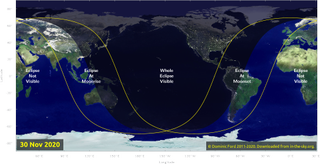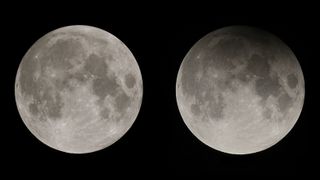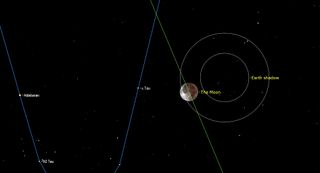Early on Monday morning (Nov. 30), careful skywatchers across all of North America can watch the full moon undergo a slight penumbral eclipse.
The moon will take 4 hours and 21 minutes to glide across the pale outer fringe (penumbra) of Earth's shadow, never reaching the shadow's dark umbra. However, penumbral lunar eclipses are rather subtle events which are usually difficult for most people to detect unless at least 70% of the moon's diameter is immersed within it.
In this particular case the November full moon, known as a Beaver moon, is going to pass rather deep into the penumbra. In fact, at the moment of the deepest phase/greatest eclipse (09:42 UT) the penumbra will cover 82.9% of the lunar disk. Put another way, the uppermost limb of the moon will be 566 miles (911 kilometers) away from the unseen edge of the much darker umbral shadow of the Earth.
Related: Lunar eclipse 2020 guide: When, where & how to see them

Phases of the Beaver moon lunar eclipse

Snap a photo of the Beaver moon lunar eclipse? Let us know! You can send images and comments to spacephotos@space.com.
About 20 minutes prior to the deepest phase of the eclipse, you might see some evidence of this faint penumbral shading on the moon's upper edge. This corresponds to around 4:22 a.m. EST (0922 GMT); 3:22 a.m. CST; 2:22 a.m. MT and 1:22 a.m. PST. About 70% of the moon's diameter will be immersed in the penumbra, so any unusual shading on the upper part of the moon should — in theory — be detectable. Some might even detect lesser traces of penumbral shading for some minutes beforehand.
After about 20 minutes, we will arrive at the deepest and most obvious part of the eclipse; the moon’s upper limb should appear sensibly shaded with a light charcoal gray or brownish colored hue.
After the deepest phase has passed, you might be able to perceive a slight darkening or "smudginess" on the moon’s right edge for around 20 additional minutes. So, while the moon will be inside the penumbral shadow for over 260 minutes, most will probably only be aware of it for only about 40 minutes.
Get the Space.com Newsletter
Breaking space news, the latest updates on rocket launches, skywatching events and more!

The penumbral eclipse will also be detectable from parts of the Caribbean and South America as the moon sets. For observers in east-central Asia, Indonesia and Australia it happens on Monday evening as the moon is rising. At mid-eclipse, the moon will appear in the zenith (directly overhead) over the North Pacific Ocean, not far from the Hawaiian Islands. From the 50th state, greatest eclipse comes late on Sunday night as the long Thanksgiving holiday weekend winds down, at 11:42 p.m. Hawaii Time.
Here is a diagram showing the moon's passage through the outer penumbral shadow on Monday, courtesy of Fred Espenak, Eclipsewise.com.
The penumbral eclipse from the moon
It might be easier to understand why the penumbral shadow of Earth is so faint, by imagining actually being on the moon when Monday's event takes place.
An astronaut on the moon during this time will see an eclipse of the sun, but it would all depend on where on the moon our hypothetical moonwalker is located. As seen from the Tycho crater, the famous brilliant lunar impact crater whose rays make it appear like a sunflower on the southern part of the moon, the Earth's silhouette will appear to only take a tiny nick off of the top of the sun; hardly enough to cause any noticeable diminishing of light on the surrounding lunar landscape. That’s why the lower part of the full moon will appear to shine normally.
In contrast, near the moon's upper limb is the region known as Mare Frigoris — the "Sea of Cold." From here, the Earth will appear to cover more than eight-tenths of the sun's diameter; consequently, the brilliant solar illumination of the surrounding lunar landscape will turn considerably more somber.
And this diminished effect of the glare and illumination of sunlight on the moon's surface is precisely what those of us in North America will be trying to detect during the deepest phase of the eclipse, when concentrating their gaze toward the upper rim of the moon early on Monday morning.
Coming attractions
In 2021, two lunar eclipses will take place, so skywatchers should mark their calendars now for these exciting moon phases.
On May 26, a total eclipse will take place. As total eclipses go, it will be unusually short, with totality lasting less than 15 minutes. The total phase will be visible before the moon sets across the western U.S. Farther east, the moon will set in total eclipse near and along a line running from the Montana-North Dakota border, southeast to the Texas-Louisiana border. Going still farther east, only the opening stages of the partial phase of the eclipse will be visible before the moon disappears beyond the west-southwest horizon.
On Nov. 19, 2021, North Americans will be treated to an almost-total eclipse. At greatest eclipse, more than 97% of the moon's diameter will be immersed in the dark umbral shadow; only a narrow sliver of the moon’s bottom edge will remain just outside of the shadow. Enough of the moon will be immersed in the umbra to allow it to light up with a coppery color as usually happens during a total eclipse. Night owls take note: Like our upcoming eclipse next Monday, as well as the eclipse in May, next November's eclipse will occur during the early morning hours.
One final note: If the weather does not cooperate and you end up being clouded out on Monday morning don't feel disappointed. Even at its peak the darkening effect on the moon will be at best, subtle.
Some may say "underwhelming."
Editor's note: If you snap a great photo of the Beaver Moon lunar eclipse or any other night-sky sight you'd like to share with Space.com and our news partners for a story or image gallery, send images and comments to spacephotos@space.com.
Joe Rao serves as an instructor and guest lecturer at New York's Hayden Planetarium. He writes about astronomy for Natural History magazine, the Farmers' Almanac and other publications. Follow us on Twitter @Spacedotcom and on Facebook.
Join our Space Forums to keep talking space on the latest missions, night sky and more! And if you have a news tip, correction or comment, let us know at: community@space.com.

Joe Rao is Space.com's skywatching columnist, as well as a veteran meteorologist and eclipse chaser who also serves as an instructor and guest lecturer at New York's Hayden Planetarium. He writes about astronomy for Natural History magazine, Sky & Telescope and other publications. Joe is an 8-time Emmy-nominated meteorologist who served the Putnam Valley region of New York for over 21 years. You can find him on Twitter and YouTube tracking lunar and solar eclipses, meteor showers and more. To find out Joe's latest project, visit him on Twitter.











